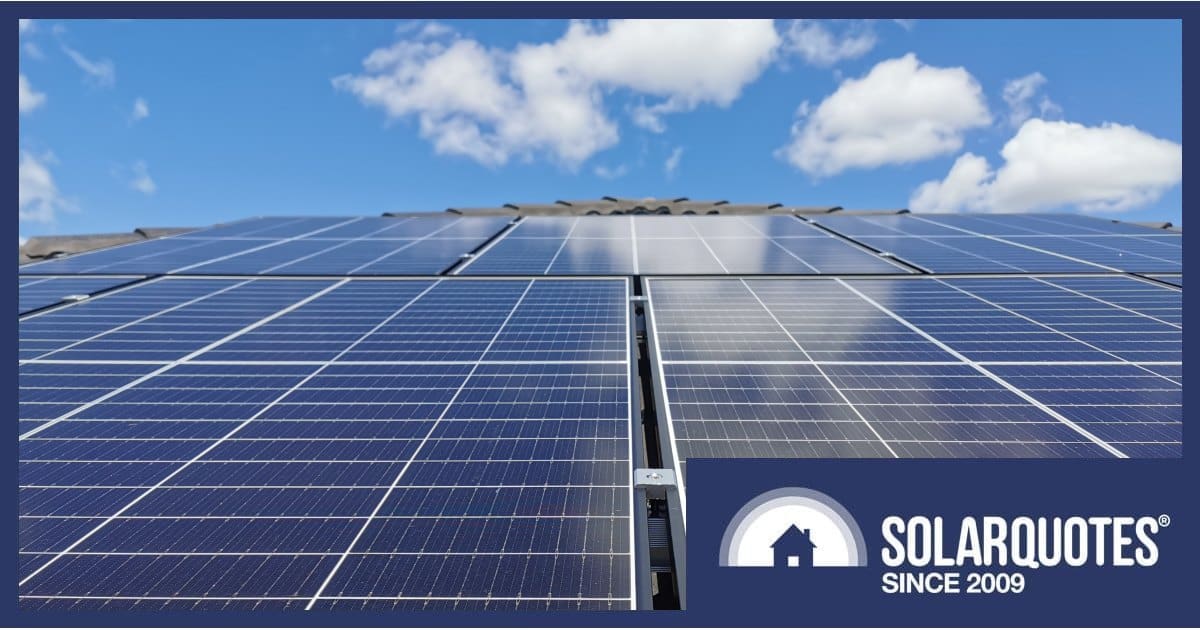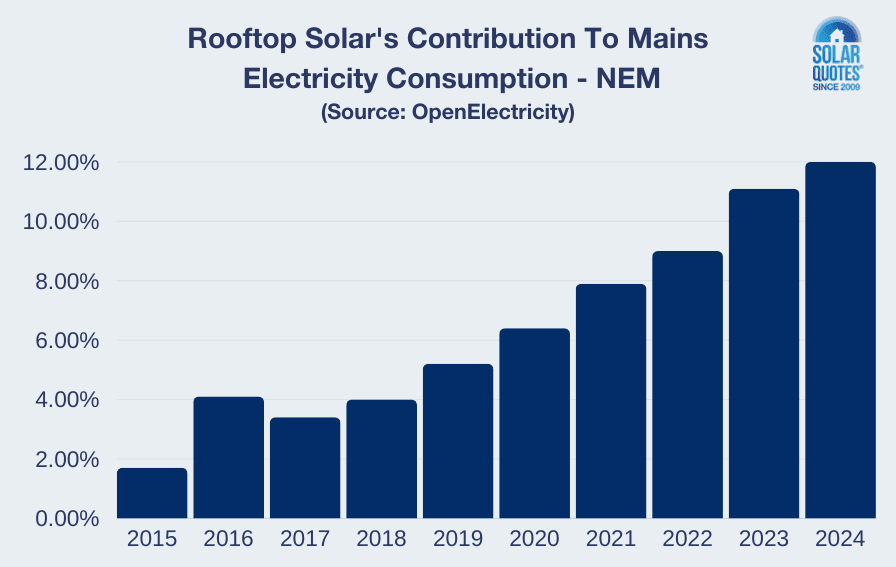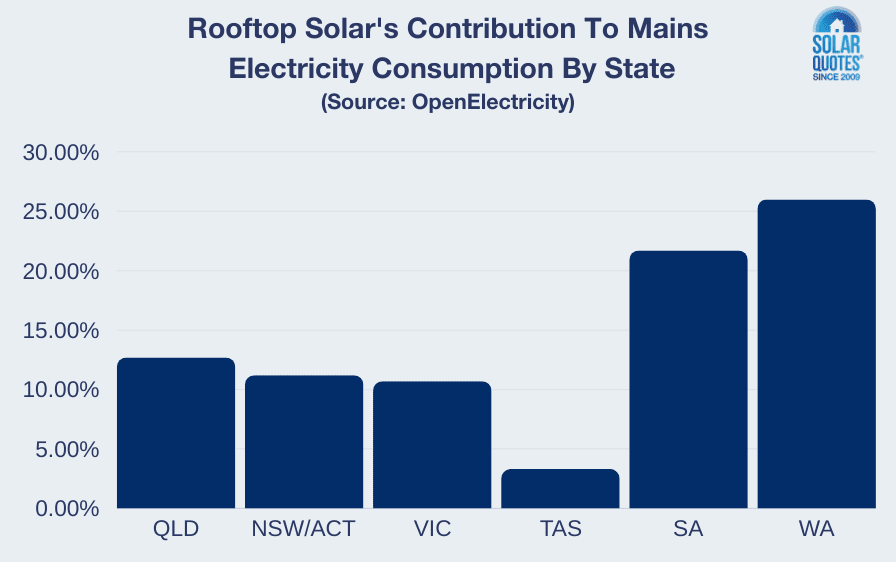
How much did rooftop solar power exports contribute towards mains grid consumption in Australia’s National Electricity Market (NEM) in 2024? Take a guess and then see the answer.
Now the calendar has flipped over to 2025 and following on from our report on Xmas day 2024 solar performance, I thought I’d take a look at how rooftop solar installed across the NEM1 performed last year in comparison to years previous.
For the full year of 2024, rooftop solar exports accounted for 25,998 gigawatt-hours of clean electricity, or 12% of NEM mains grid consumption according to OpenElectricity. Here’s a list showing the rise over the last 10 years:
- 2024: 12.0%
- 2023: 11.1%
- 2022: 9.0%
- 2021: 7.9%
- 2020: 6.4%
- 2019: 5.2%
- 2018: 4.0%
- 2017: 3.4%
- 2016: 4.1%
- 2015: 1.7%
Or in a graph:
But added to these figures is the electricity generated by solar owners that didn’t make it to the grid; i.e. it was self-consumed; avoiding what would be a very significant amount of mains grid demand.
2024 State By State
The following shows the percentage of mains electricity consumption met by rooftop solar exports in each NEM state for 2024.
- Queensland: 12.7%
- New South Wales & ACT: 11.2%
- Victoria: 10.7%
- Tasmania: 3.3%
- South Australia: 21.7%
What About WA And NT?
Western Australia is outside of the NEM, but there are figures available for WA’s main electricity network – the South West Interconnected System (SWIS). According to OpenElectricity, rooftop solar energy contributed around 26% of SWIS consumption in 2024, up from 25.2% in 2023.
As for the Northern Territory, I don’t have any figures. But for those states I do, another graph:
Australian Rooftop Solar Installations In 2024
According to Australia’s Clean Energy Regulator (CER) and based on figures last updated on November 30, there had been 266,865 small-scale (<100 kW capacity) systems installed to that point in 2024. While this figure appears well down on 2023 (333,548 installation), there was a month to go and given the way the CER compiles these figures, it will be well into 2025 before we’ll have a final tally. While the final count may be lower than 2023, the average size of systems is continuing to grow.
As for a cumulative total to November 30, the Regulator indicates 3,989,852 small-scale PV systems had been installed in Australia, with a collective capacity just north of 25 gigawatts.
Renewables Overall In 2024
Last year, renewables-generated electricity accounted for 38.8% of electricity consumed across the NEM, up just a tad from 38.6% in 2023 due to poorer performance from hydro. 20 years ago, in 2004, renewables’ share was just 2.5%. That same year, black and brown coal accounted for 92.3% of consumption, compared to 55.5% last year. So, we’ve come a long way – but there’s still a way to go.
As for the role of gas-fired generation in electricity consumed, in 2004 its share was 5.1%, and last year it was 5.3%.
Going Solar In 2025
If you’re considering installing solar panels early on in 2025, there’s some good news. While Australia’s solar panel rebate (in practice, an up- front discount) drops each year on January 1, it’s still quite generous and the value of STCs (on which the rebate is based) still look to be bumping up against their maximum possible value. For example, a 10kW solar system installed in Sydney should provide a rebate of around $3,000 after admin fees.
The other bit of good news is even though the Australian dollar hasn’t been faring too well against the greenback, with solar manufacturers engaging in what one industry executive described as “irrational” competition, this has maintained low solar power system prices (for now).
While you should never rush a solar purchase decision – do your research first – bear in mind each month your rooftop is bereft of solar panels is another month you’ll be paying much more for electricity than you otherwise would. And particularly during these hotter months, that could really add up.
Footnotes
- The NEM is made up of Queensland, New South Wales (including the ACT), Victoria, Tasmania and South Australia. ↩



 RSS - Posts
RSS - Posts



With the excess solar being curtailed during the day, Isn’t it time to change off peak water to heat during the day at cheap rates. Would reduce bills for many.
Great idea – off-peak tariffs have been rising steadily and now are almost at peak tariff levels; instead of surplus solar going to waste, let’s get our hot water supply at a low tariff which reflects the lack of demand during the day, say 10 am to 3 pm.
There’s been a few million dollars spent investigating this…
click here for the answers
My own learned experiences with solar and diverter has proven this works. Can’t work out the study suggesting 45,% of load shifting, I did 100%.
Several regions with smart meters already do this – enable controlled loads (“off peak” hot water systems) during sunny days – and charge the same cheaper rates.
e.g. AusGrid in Sydney also switches my hot water heater on for an hour or two around mid-day, probably to stabilise the grid from all the excess solar.
You can get a sparky to rewire things to make it even cheaper:
https://www.solarquotes.com.au/blog/solar-for-controlled-loads
https://www.solarquotes.com.au/blog/solar-hot-water-timer
but that costs more money, perhaps more than you would save?
With WA, I suspect that with the price of exported power so low, new installations are being paired with batteries for self consumption.
I’ve seen between 0-3c kwh